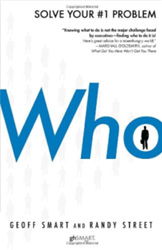October 2015: In This Issue
Welcome to the October issue of A New Leaf!
The fourth quarter offers many LEADERS and teams an opportunity to address their 2016 STRATEGY. While this may be constructive, making this solely a fourth quarter activity is suboptimal for many reasons, including the following:
For STRATEGY to be effective, it must be dynamic. Time must be set aside throughout the year for leaders and managers to assess the relative success of their tactics and strategy. Institutionalizing strategic change must become a way of doing business. Such ongoing reassessment is necessary for your strategy to remain responsive to a competitive and ever changing marketplace.
Just as important as being dynamic, effective STRATEGY requires having internal talents necessary for effective execution. As set forth in Jim Collin’s “Good to Great” concept of “First Who, then What”, absent having the right people on the right seats on the bus, any STRATEGY is doomed to be marginalized. Accordingly, the most important decisions that businesspeople make are not “what” decisions (strategy and tactics) but “who” decisions.
This month’s reviewed reading provides LEADERS with a comprehensive methodology to address the WHO decisions in their organization. It offers a proven process of assessing the outcomes and competencies required for your key positions and interviewing techniques directed at ensuring “A” players are found and hired.
To the extent your team will be engaged in an upcoming STRATEGY process, challenge them early to address whether your organization possesses sufficient “WHO” capabilities to effectively execute the “WHAT” tactics. Absent an affirmative response, is there anything more important for you to focus on in this year’s planning than “First Who, then What”?- Mike

Book Review: “Who-The A Method for Hiring” by Geoff Smart and Randy Street
The premise in Geoff Smart’s and Randy Street’s (Smart) “WHO” is that the success of any manager or leader is simply the result of how good you are at hiring the people around you. Hiring failures impact every aspect of our professional and personal lives. Smart’s research supports that the cost of hiring mistakes is over fifteen times an employee’s base salary and lost productivity. In addition, Peter Drucker and other leadership experts estimate that the hiring success of managers is at best 50%.
While these statistics may seem staggering, the good news is that “WHO” mistakes ARE preventable. By following Smart’s “A Method for Hiring”, all managers can significantly increase the quality of the talent they hire while simultaneously enhancing the probability of their own success.
Smart asserts that “in business, you are who you hire. Hire C players and you will always lose to the competition. Hire B players, and you might do ok, but you will never break out. Hire A players, and life gets very interesting no matter what you are pursuing”. But just what is an “A” player? An “A” player is “a candidate who has at least 90 percent chance of achieving a set of outcomes that only the top 10 percent of possible candidates could achieve.” “A” players significantly stack the odds in your favor (90%) that they will accomplish not just good, but great, things in their role (top 10%).
In discussing how to hire “A” players, Smart suggests that the most prevalent hiring mistakes happen when managers:
- Are unclear about what is needed in a job
- Have a weak flow of candidates
- Do not trust their ability to pick out the right candidate from a group of similar looking candidates
- Lose candidates they really want to join their team.
Smart challenges all leaders to assess whether their managers are making these mistakes by counting the number of ”A players” present in their organizations. They specifically point to ten “voodoo hiring methods” that plagued most companies. Following are three of these failing hiring methods:
*The Art Critic-When it comes to judging art, going on gut instincts works fine. If you extend an offer based upon gut instincts, you are going to have a stomachache!
*The Sponge-A common approach among busy managers is to let everybody interview a candidate. The Sponge’s ultimate assessment of the person he hires rarely goes deeper than “he’s a good guy”.
*The Aptitude Tester-Tests can help managers determine whether a person has the right aptitude for a specific role but they should never become the major determinant in a hiring decision. As aptitude is only a part of a much larger equation, assessments should never be used in isolation.
Having detailed the mistakes and poor hiring practices present in most organizations, WHO sets forth a comprehensive model significantly increasing the odds of finding and hiring “A” players. The “A Method For Hiring” is comprised of the following four steps:
*Scorecard. The scorecard is a document describing exactly what you want the person to accomplish in the role. It is not a job description, but instead a set of outcomes and competencies that define a job well done. Defining “A” performance for the role paints a clear picture of what the person you seek needs to be able to accomplish.
*Source-Finding great people is getting harder. Systematic sourcing before you have slots to fill is required to ensure that you have high quality candidates waiting when you need them.
*Select-Selecting the right talent involves a series of four, focused interviews that allows you to gather the relevant facts about a person to rate your scorecard and make an informed hiring decision. Structured interviews break the poor practices arising from the ten “voodoo hiring practices”.
*Sell-Once you identify people you want on your team, you need to be able to persuade them to join. Selling the right way ensures you avoid the biggest pitfalls that cause the very people you want to take their talents elsewhere.
Smart dedicates individual chapters to robust discussion and examples associated with each of the above steps of their “A Method For Hiring”. Following is a discussion of the Select step of the model which consists of the four separate interviews designed to provide the necessary facts to assess a person against the originally established job Scorecard:
The Screening Interview: This is a short, phone based interview designed to clear out B and C players. It is comprised of obtaining answers to the following four questions:
- What are your career goals?
- What are you really good at professionally?
- What are you not good at or not interested in doing professionally?
- Who were your last five bosses and how will they each rate your performance on a 1-10 scale when we talk?
Each question requires follow up using open ended “How” or “What” questions to obtain further information about the candidate. Using four consistent questions is essential to building a fact base for eliminating underperformers or poor fits for your business.
The Topgrading Interview: This second interview is a chronological walk through of the candidate’s career. It begins by asking about the highs and lows of a person’s educational experience to gain initial insight into their background. Then, in chronological order, the following questions are asked about each job over the last 15 years:
- What were you hired to do?
- What accomplishments are you most proud of?
- What were some low points during that job?
- Who were the people you worked with?
- Why did you leave that job?
Smart cautions that it is critical that the interviewer drills down during each question to obtain accurate and complete responses during this important step.
The Focused Interview: This third interview focuses on assessing the alignment of the candidate’s skills/experience with the specific Scorecard outcomes and competencies. For each key competency and outcome, the following feedback is pursued:
- What are your biggest accomplishments in this area in your career?
- What are your insights into your biggest mistakes and lessons learned from this area?
The Reference Interview: This final interview requires the manager to do three things correctly; picking the right references, asking the candidate to set up the interviews, and conducting the right number of interviews. WHO recommends seven reference interviews to be effective. The following five questions are used for this interview:
- In what context did you work with this person?
- What were the person’s biggest strengths?
- What were the person’s biggest areas for improvement?
- How would you rate his performance on a 1-10 scale and why?
- The person mentioned that they struggled in this part of the job. Can you tell me more about that?
The key to this interview is to pay very close attention to what people say and how they say it. A reference who hesitates is typically trying hard not to say something negative about the candidate.
Having gone through this extensive interview process, the “A Method For Hiring” consists of the following next steps:
- Assess the candidate against all aspects of the original Scorecard
- If you have no A’s, restart the process at the Sourcing step
- If you have one A, decide to hire that person
- If you have multiple A’s, rank them and decide to hire the best.
The “A Method For Hiring” significantly increases your chances of finding the best person to fill your position. It “takes hard work… you have to dig hard, ask tough questions, and be prepared for disturbing answers”.
How many “A” players does your organization have? How high is your employee retention rate? How does your process compare to the “A Method For Hiring”?
Most organizations hiring practices are in need of improvement. If yours is one of them, a full reading of “WHO” may be the first place to start in upgrading the quality and quantity of “A” players in your organization.©2013 See Change Management. All Rights Reserved. Site credit


